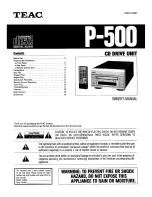
Accelnet & Stepnet Plus Panels User Guide
16-01339 Rev 07
C
URRENT
L
OOP
G
AINS
The current loop uses these gains:
Gain
Description
Cp - Current loop proportional
The current error (the difference between the actual and the limited
commanded current) is multiplied by this value. The primary effect of this
gain is to increase bandwidth (or decrease the step-response time) as the
gain is increased.
Ci - Current loop integral
The integral of the current error is multiplied by this value. Integral gain
reduces the current error to zero over time. It controls the DC accuracy of
the loop, or the flatness of the top of a square wave signal. The error
integral is the accumulated sum of the current error value over time.
C
URRENT
L
OOP
O
UTPUT
The output of the current loop is a command that sets the duty cycle of the PWM output stage of the drive.
This provides a variable voltage-source.
A
UTO
T
UNE
CME provides a current loop Auto Tune feature, which automatically determines optimal Cp and Ci values for
the motor. For more information, see the CME User Guide.
V
ELOCITY
M
ODE AND
V
ELOCITY
L
OOP
V
ELOCITY
L
OOP
D
IAGRAM
As shown below, the velocity loop limiting stage accepts a velocity command, applies limits, and passes a
limited velocity command to the command filter. The output of the filter is a velocity command to the summing
junction. The summing junction subtracts the actual velocity derived from the feedback device (encoder,
resolver), and produces a velocity error signal. The velocity loop feedback signal is always from the motor
feedback device even when an additional encoder is attached to the load. The velocity error is then processed
using the integral and proportional gains which is added to a feedforward signal to produce the commanded
current. Programmable digital filters are provided on the input of the velocity loop, following the limiting stage,
and on the output of the velocity loop that will become the commanded current which controls the current loop.
















































